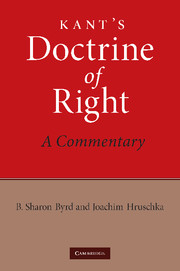Book contents
- Frontmatter
- Contents
- Introduction and methods of interpretation
- Chapter 1 The idea of the juridical state and the postulate of public law
- Chapter 2 The state of nature and the three leges
- Appendix to Chapter 2 Iustitia tutatrix, iustitia commutativa, and iustitia distributiva and their differences
- Chapter 3 The right to freedom
- Chapter 4 The permissive law in the Doctrine of Right
- Chapter 5 The external mine and thine
- Chapter 6 Intelligible possession of land
- Chapter 7 The “state in the idea”
- Chapter 8 The state in reality
- Chapter 9 International and cosmopolitan law
- Chapter 10 The “idea of public law” and its limits
- Chapter 11 Contract law I. Why must I keep my promise?
- Chapter 12 Contract law II. Kant's table of contracts
- Chapter 13 Criminal punishment
- Chapter 14 The human being as a person
- Appendix I to Chapter 14 On the logic of “‘ought’ implies ‘can’”
- Appendix II to Chapter 14 The system of rules of imputation
- Bibliography
- Index
Introduction and methods of interpretation
Published online by Cambridge University Press: 05 June 2012
- Frontmatter
- Contents
- Introduction and methods of interpretation
- Chapter 1 The idea of the juridical state and the postulate of public law
- Chapter 2 The state of nature and the three leges
- Appendix to Chapter 2 Iustitia tutatrix, iustitia commutativa, and iustitia distributiva and their differences
- Chapter 3 The right to freedom
- Chapter 4 The permissive law in the Doctrine of Right
- Chapter 5 The external mine and thine
- Chapter 6 Intelligible possession of land
- Chapter 7 The “state in the idea”
- Chapter 8 The state in reality
- Chapter 9 International and cosmopolitan law
- Chapter 10 The “idea of public law” and its limits
- Chapter 11 Contract law I. Why must I keep my promise?
- Chapter 12 Contract law II. Kant's table of contracts
- Chapter 13 Criminal punishment
- Chapter 14 The human being as a person
- Appendix I to Chapter 14 On the logic of “‘ought’ implies ‘can’”
- Appendix II to Chapter 14 The system of rules of imputation
- Bibliography
- Index
Summary
The Doctrine of Right is Kant's masterpiece on legal and political philosophy. The work is highly structured and meticulously formulated. In it Kant makes a few simple assumptions he calls “axioms” and “postulates” and from those assumptions the whole doctrine of right unfolds systematically. It unfolds Kant's most mature thoughts on the peace project. As Kant indicates in the Conclusion to the Doctrine of Right, the whole aim of that work is to ensure lasting peace. Peace is ensured in Kant's view by securing and protecting individual rights. Thus Kant's most significant contribution to legal and political philosophy is dedicated to the peace project and is about rights and how those rights can be ensured.
Rights can be ensured only in a “juridical state.” Kant fathered the idea of a juridical state, which in German is called the Rechtsstaat, or in English a state under “the rule of law,” a state guaranteeing “due process of law.” Unlike authors before, during, or after Kant's time, Kant expands his inquiry beyond the juridical state of one nation to include the juridical state of nation states and the cosmopolitan juridical state. Kant's ideas thus encompass international law to ensure rights globally and cosmopolitan law to ensure world trading relations and permit peoples to offer themselves freely for commerce with one another. Kant indeed is the only author who provides one single model designed to ensure peace on the national, international, and cosmopolitan levels.
- Type
- Chapter
- Information
- Kant's Doctrine of RightA Commentary, pp. 1 - 22Publisher: Cambridge University PressPrint publication year: 2010



